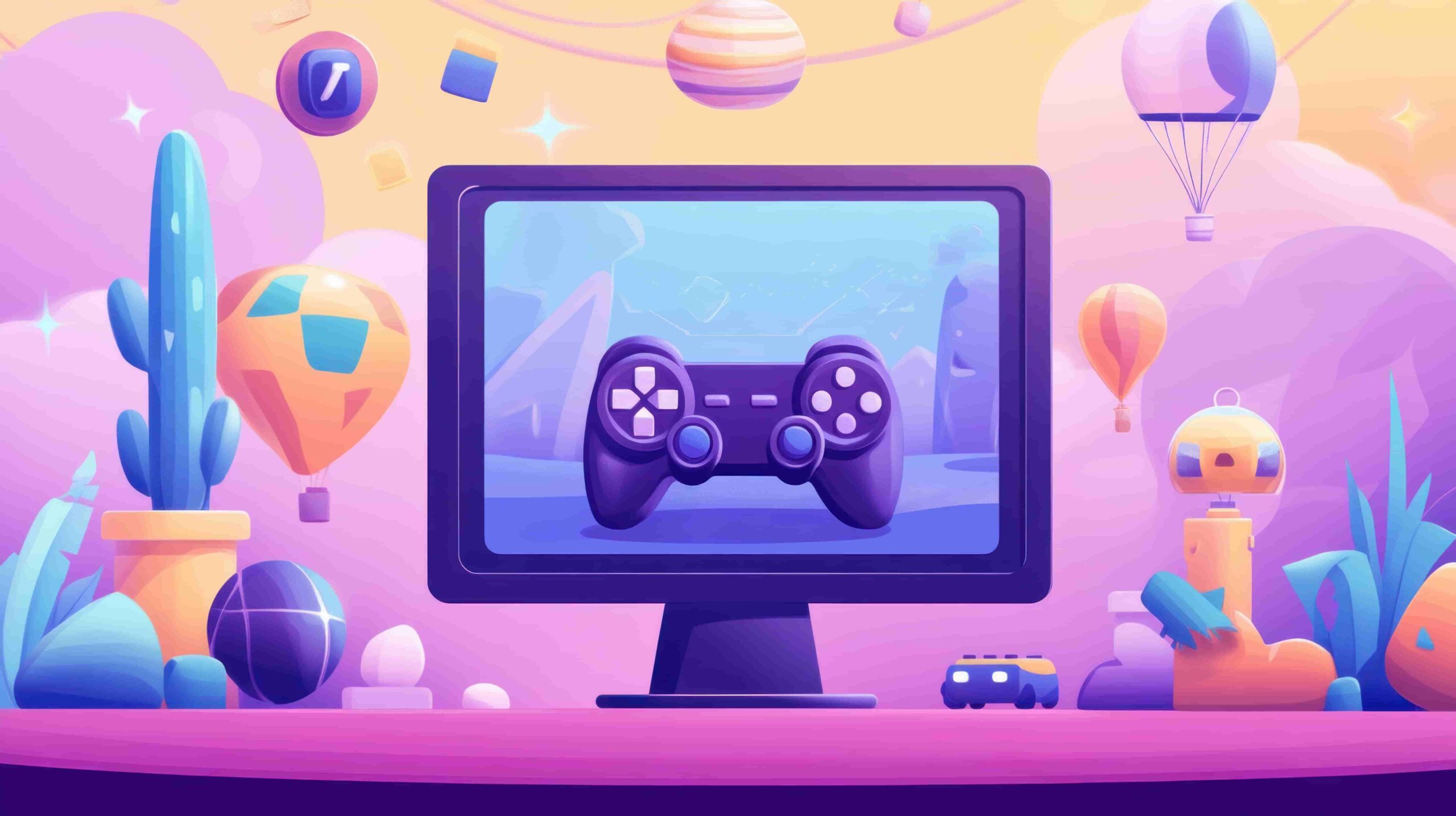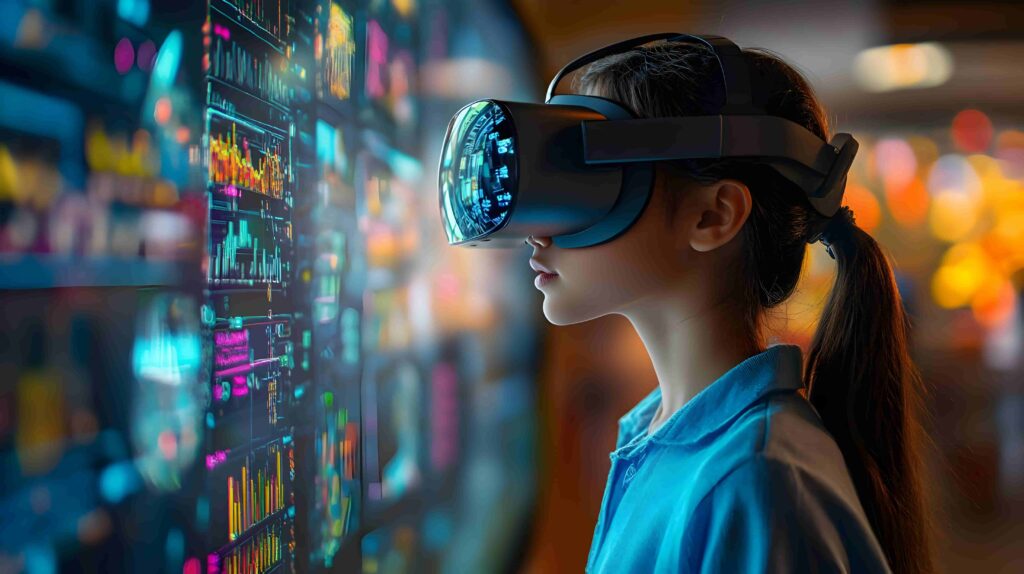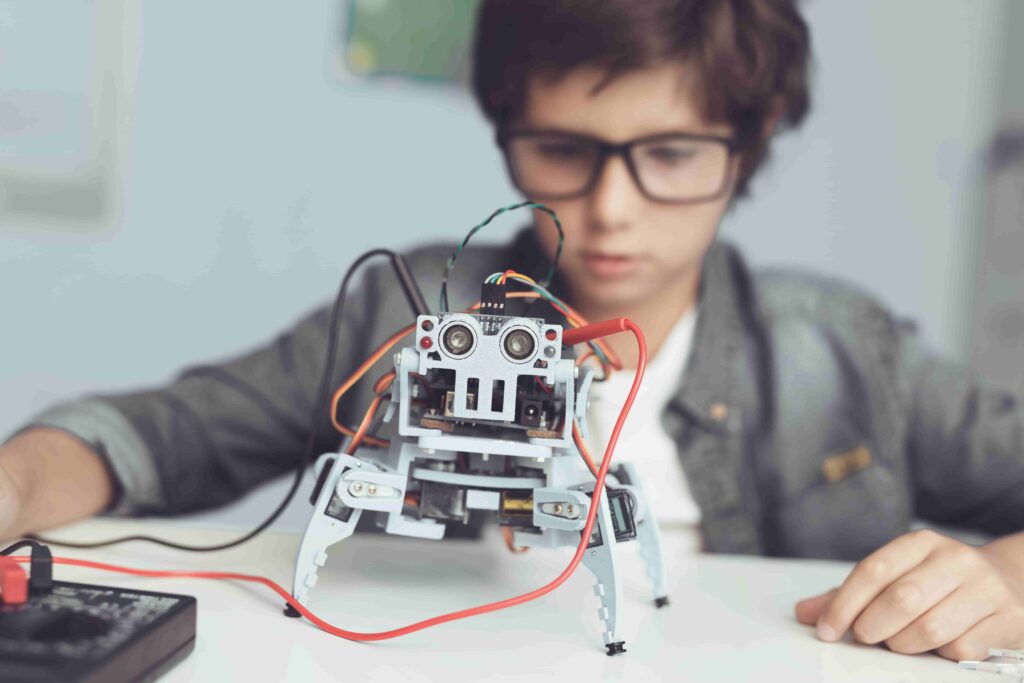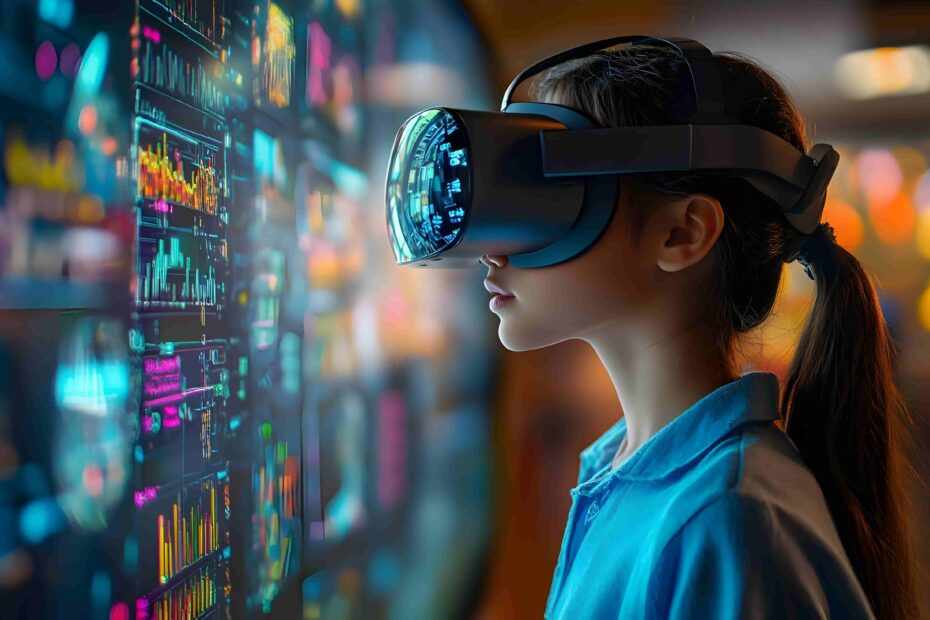How the digital revolution is reshaping the way we learn

Digital transformation is revolutionizing education, changing the way students learn and teachers teach.
Tools such as tablets, interactive whiteboards and online platforms are replacing traditional methods, making learning more dynamic and accessible.

Gamification: Transforming Education
Discover how gamification transforms education and work by engaging, motivating and developing skills with game-based strategies.
However, this transition goes beyond modernizing education: it is about preparing students for a technological future.
Despite the opportunities, challenges such as inequality of access and teacher training show that adapting to the digital age requires a joint effort.
How are schools dealing with this revolution? Discover in this article how technology is shaping the future of education.
The Digital Revolution Comes to Schools
Digital transformation is rewriting the rules in almost every industry, and education has not been left out of this revolution. Technological tools are redefining what it means to teach and learn, breaking down barriers that once seemed insurmountable.
From traditional whiteboards to digital devices, the classroom has become an interactive, connected environment, allowing teachers and students to access resources that were previously beyond their reach. But along with opportunities come challenges.
How are schools adapting? What resources are being used? What challenges are teachers and administrators facing? Throughout this article, we will answer these questions and more.
Technological Resources: The Future in the Classroom
The presence of technological devices in the classroom is changing the dynamics of teaching. It is not just about replacing books with tablets, but about using technology as a tool to enrich learning.
Technological devices are not just tools, but true facilitators of learning:
Devices that Transform Teaching
- Tablets and Notebooks
- They allow instant access to online educational resources.
- They offer tools such as text editors and spreadsheets for practical activities.
- Facilitate personalization of learning with adaptive applications.
- Interactive Whiteboards
- They replace traditional whiteboards, allowing teachers to interact with digital content.
- They allow students to collaborate directly, creating a more engaging experience.
- Virtual Labs
- They offer simulations of scientific experiments.
- They make it possible to practice chemistry, physics and biology without the need for large investments in equipment.
Online Teaching Tools
Platforms like Google Classroom and Microsoft Teams not only organize content and activities, but also create a continuous communication channel between students and teachers.
- With the Google Classroom, for example, you can assign tasks, grade work, and provide feedback instantly.
- THE Microsoft Teams integrates video calls, chats and file sharing, facilitating hybrid teaching.
In addition to centralizing the material, these tools allow the use of resources such as automatic quizzes, which assess student performance in real time.
This integration increases learning efficiency while saving teachers time.
The Impact of Online Learning Platforms
Online learning platforms have transformed the way students access and absorb knowledge.
These tools offer flexibility, global reach and innovative features, revolutionizing the traditional education system.
One of the biggest impacts of online learning platforms is the democratization of education. Tools such as Khan Academy, Coursera and edX allow anyone with internet access to study a variety of topics, from basic math to advanced professional skills.
Additionally, many of these courses are free or offer affordable certificates, making learning more inclusive.
For example:
- Students in remote regions can access classes from renowned institutions, something that was previously unimaginable.
- People at different stages of life, such as workers or parents, can adapt their studies to their schedules.
Examples of Popular Platforms
| Platform | Objective | Target Audience |
|---|---|---|
| Khan Academy | Free classes in various subjects. | Elementary and high school. |
| Coursera | Online courses from renowned universities. | Higher education and professionals. |
| edX | High quality certifications. | Students and professionals. |
In addition to these, other regional or specific options emerge, such as platforms aimed at academic support, technical education or preparation for university entrance exams.
These resources make learning more accessible, especially for those looking to expand or diversify their knowledge outside of the traditional school environment.
Benefits of Hybrid Learning

Studies show that using online platforms can increase engagement and academic performance.
Students who use tools like interactive quizzes and collaborative forums learn more than those exposed only to the traditional method.
These platforms also encourage important 21st century skills such as self-discipline, responsibility and continuous learning, preparing students for an increasingly dynamic job market.
Examples of Global Impact
- Coursera for Campus: During the pandemic, many universities adopted this platform to offer complementary courses to their students.
- Google for Education: Tool widely used in schools to organize remote teaching and create collaborative experiences between students and teachers.
Gamification: Making Learning Fun
Gamification has been gaining more and more space in the educational environment, transforming the learning process into an engaging and interactive experience.
By incorporating game elements such as challenges, scores and rewards, gamification encourages students to learn in a fun and motivating way.
Its success lies in the way it activates the human brain’s reward system. When students complete challenges or achieve goals, they experience a sense of achievement that encourages continued learning.
Proven Benefits
Studies show that gamification significantly increases engagement and content retention.
- Engagement: Studies show that students learn more when they are engaged.
- Healthy Competition: Rankings and challenges encourage active participation.
- Memorization: Repetition in a game format reinforces learning.
Popular Tools
- Kahoot!: Teachers create interactive quizzes that can be played individually or in groups, turning content review into a healthy competition.
- Duolingo: In language teaching, the app uses daily challenges, levels and rewards to keep users motivated.
- Minecraft Education Edition: An adapted version of the popular game, where students can explore math, science and history concepts while building their own virtual worlds.
With these tools, teachers have a powerful arsenal at their disposal to transform teaching.
Personalizing Education with Artificial Intelligence
Artificial intelligence (AI) has revolutionized many sectors, and education is no exception. The personalization of education, driven by advanced technologies, is transforming the way students learn and teachers teach.
With AI, it is possible to adapt learning to the specific needs of each student, promoting more effective and inclusive teaching.

The Most Popular Apps to Listen to Free Music
Want to listen to music without paying? Check out our list of the best apps to listen to music for free, offline and without ads!
How AI Works in Education
- Educational Data Analysis
- AI platforms collect and analyze data on student performance, identifying patterns and gaps in learning.
- This data helps create personalized study plans that focus on the areas the student needs to improve.
2. Adaptive Content
- Tools like DreamBox and Khan Academy automatically adjust the difficulty level of activities based on the student's progress.
- This process keeps students challenged without causing frustration.
3. Real-Time Feedback
- AI provides instant feedback, allowing students and teachers to quickly identify areas for improvement.
- This helps to speed up the learning process and correct mistakes effectively.
With the advancement of artificial intelligence, personalized learning is becoming more accessible and effective. In the future, it is possible to imagine systems that not only adjust content but also offer immersive experiences, such as virtual tutors in augmented reality.
Personalizing education with AI is more than a trend — it’s a revolution that can transform education into an inclusive, tailored, and efficient process, promoting the individual success of each student.
Expanding Access to Education
Technology is a powerful bridge to connect students in remote regions to quality education.
Distance learning has been a solution to reduce educational exclusion, allowing students in less advantaged areas to access the same content as top urban institutions.
Before the digital age, access to education was limited by geographic, economic, and social barriers. Today, tools like online learning platforms and affordable devices are breaking down these barriers.
- Distance Learning
- Online courses allow students to study from anywhere, even without the need for physical travel.
- The hybrid model, which combines in-person and remote classes, further expands learning opportunities.
- Accessible Resources
- Low-cost tablets and laptops, like those in the program One Laptop per Child, allow students in remote areas to access digital learning.
- Educational software, much of it free, is available to complement traditional education.
- Internet as an Educational Tool
- Connectivity programs such as Connected Education in Brazil, they bring internet to public schools in rural areas.
- Digital libraries provide pre-downloaded content for regions with limited connectivity.
Inspiring Initiatives
Several initiatives around the world have shown that technology can transform the educational landscape:
- Khan Academy Offline: Allows students in areas without internet access to use previously downloaded educational content.
- Internet for All: Government and NGO projects that bring connectivity to isolated communities.
- Mobile Digital Libraries: Trucks equipped with computers that travel to remote regions to provide access to technology.
Benefits of Distance Learning
Online learning not only eliminates geographical barriers, but also tailors teaching to the individual needs of each student.
This is particularly important for adults who need to combine studies with work or for young people who live far from major educational centers.
Furthermore, the cost-benefit is significant: families save on transportation, physical materials and food, while governments invest in digital infrastructure that benefits multiple areas, such as health and communication.
Digital Transformation Challenges

Digital transformation has been a powerful force for innovation in education, but its implementation is not without its difficulties.
Despite technological advances, schools, teachers and students face a series of challenges that need to be overcome for digital education to reach its full potential.
1. Limited Infrastructure
Lack of infrastructure is one of the biggest obstacles, especially in rural or low-income areas. Many schools still lack access to high-speed internet, enough computers, or up-to-date devices.
- Scenario in Brazil: According to the School Census, around 40% in urban public schools and more than 70% in rural schools do not have adequate access to the internet.
- Impact: This limits the use of educational platforms, interactive tools and online resources, creating inequality in access to digital education.
2. Teacher Training
Many educators still don’t feel ready to integrate technology into their teaching. While young teachers may be more familiar with digital tools, experienced educators often struggle to adapt to the new learning environment.
- Possible Solutions:
- Ongoing training programs, such as technology workshops and pedagogical use of online platforms.
- Incentives for teachers to qualify in technological areas, promoting greater confidence and efficiency in the use of tools.
3. Digital Inequality
The digital divide — also known as the digital divide — is a global problem. While some schools have modern resources, many others lack basic access to technology. This gap amplifies social inequalities, putting students from disadvantaged areas at a disadvantage.
- Consequences: Students from families with lower purchasing power may not have access to computers or the internet at home, making it difficult to continue their studies in hybrid or fully digital environments.
4. Implementation Cost
Implementing educational technologies involves significant costs: purchasing devices, software licenses, equipment maintenance and teacher training.
- Barriers: Small public and private schools often do not have sufficient budgets to invest in cutting-edge technology.
- Alternatives:
- Public-private partnerships can offer low-cost solutions, such as tablet loans and affordable educational packages.
- Crowdfunding projects to raise funds for the acquisition of devices and infrastructure.
5. Cultural Resistance
Not everyone involved in the educational process sees technology as an ally.
- Parents and Students: Some parents believe that digital learning is not as effective as traditional learning, while students may resist using new tools.
- Teachers: Some faculty may prefer traditional teaching methods, believing that technology does not add as much value as established techniques.
Ways to Overcome Challenges
Digital transformation in education is inevitable, but its implementation requires planning, resources and an inclusive approach.
By addressing these challenges, the education sector will be better prepared to use technology as a force for inclusion, innovation and progress.
Some points can be improved to overcome these challenges, such as:
- Government Incentives: Subsidies for the acquisition of devices and infrastructure.
- Continuous Training: Regular training for teachers and school managers.
- Local Initiatives: Partnerships with communities to seek solutions adapted to the reality of each region.
Security and Privacy: Protecting School Data
With the increasing adoption of digital technologies in education, data security and privacy have become critical issues.
Schools, teachers and students share sensitive information on online platforms, from personal data to academic records, making them potential targets for cybercriminals.
Protecting this information is essential to creating a safe and trustworthy learning environment.
Why Are Security and Privacy Crucial?
- Increased Data Volume
- Educational platforms collect information such as name, address, educational history and even learning preferences.
- Sensitive teacher data, such as payment details, are also stored in these systems.
- Associated Risks
- Cyber Attacks: Schools can be targeted by hackers looking to steal data for extortion or sale.
- Misuse of Information: Some platforms use user data for commercial purposes without explicit consent.
- Accidental Exposure: Flaws in security configurations can expose information to unauthorized individuals.
Good Practices
1. Strict Privacy Policies: Schools and educational platforms must adopt clear policies on data collection, storage, and use. Ensure that everyone involved — students, parents, and teachers — knows how their information is protected.
2. Use of Reliable Tools: Choose software that is recognized for its security and that complies with data protection regulations, such as the LGPD (General Data Protection Law) in Brazil and the GDPR in the European Union. Avoid free platforms that may monetize user data without proper consent.
3. Digital Security Training: Conduct regular training for teachers, students and managers on safe online practices, such as:
- Identify phishing messages.
- Create strong and unique passwords.
- Update devices regularly to fix vulnerabilities.
4. Data Encryption: Sensitive information should be encrypted both in transit (when sent) and at rest (when stored). This ensures that even if the data is intercepted, it cannot be read without an access key.
5. Regular Monitoring and Audits: Schools should monitor the use of digital platforms to identify suspicious activity. Regular audits help assess the effectiveness of security measures and address vulnerabilities.
Furthermore, compliance with data protection laws, such as the LGPD (General Data Protection Law) in Brazil and the GDPR in the European Union, is essential.

Education Apps: Learn New Skills
Explore the best education apps and discover tools to learn new skills, languages and knowledge in a practical way.
Social Networks: Allies or Villains in Education?
Social media can be a powerful educational resource, but it also brings significant challenges.
The secret lies in the balanced and conscious use of these platforms.
Educational Benefits
- Access to Content: YouTube is one of the biggest sources of self-directed learning, with lessons on everything from basic math to advanced technology skills.
- Communication: Groups on WhatsApp or Facebook allow teachers to share information with students.
- Learning Community: Groups on Facebook or WhatsApp can be used to share materials and answer questions.
Challenges and Risks
Although social networks are useful, they also present dangers:
- Disinformation: It's easy to find low-quality or inaccurate educational content.
- Cyberbullying: Many students face online bullying, affecting their academic performance and emotional well-being.
- Distractions: Too many notifications and non-educational content can impair concentration.
Strategies for Positive Use
- Digital Education: Teach students to check sources and evaluate the quality of information.
- Moderation: Teachers must monitor and guide the responsible use of networks.
- Social Media Guidance: Schools should include classes on responsible behavior on the internet.
- Monitoring: Teachers and parents should supervise how social media is used by students.
When used correctly, social media can complement learning and foster a more meaningful connection between students and educators.
Virtual Reality and the Future of Education
Virtual (VR) and augmented (AR) reality are reshaping learning, providing immersive experiences that bring learners closer to the content than ever before.
Application Examples
- Virtual Travel: Students can explore historical sites or visit museums without leaving the classroom.
- Practical Training: Medical, engineering and aviation students can practice complex scenarios without real risks.
- World Exploration: With VR, students can visit historical ruins, explore distant ecosystems, or even “travel” through space.
- Virtual Labs: Simulations of chemical or physical experiments allow for safe and accessible learning.
Long-Term Benefits

- Engagement: Immersive learning is more engaging and retains attention for longer.
- Augmented Memorization: Studies show that people retain more information with VR than traditional methods.
- Inclusion of Students with Special Needs: VR technologies can be adapted to suit different learning styles and abilities.
Despite the high costs, the popularization of this technology could make it accessible in the near future.
Inspiring Examples Around the World
Several schools and initiatives around the world are showing how technology can transform education:
- Finland: A country that prioritizes educational innovation, integrating digital tools into subjects from an early age, promoting creativity and critical thinking.
- Brazil: The use of platforms like Geekie, focused on personalizing learning, has shown positive results in academic performance.
- Sub-Saharan Africa: With initiatives such as “Bridge International Academies”, which use tablets to offer standardized teaching at a reduced cost.
These examples show that, with planning and investment, technology can be a powerful ally in building a fairer and more efficient education.
Digital Inclusion: A Global Challenge
Digital inclusion is essential so that all students have the same learning opportunities.
However, this is a challenging goal, especially in developing countries.
Current Barriers
- Inequality of Access: In many regions, access to the internet and devices is still a privilege, not a norm.
- High Cost: Many families and schools cannot afford to purchase modern equipment.
- Lack of Infrastructure: The lack of stable connections or electricity in rural areas limits digitalization.
Possible Solutions
- Government Investments: Programs like “Connected Education” seek to equip public schools with high-speed internet.
- Private Partnerships: Companies like Google and Microsoft have launched projects to provide low-cost technologies.
- Teacher Training: Real inclusion depends on educators who are prepared to use new tools effectively.
With coordinated actions, digital inclusion can become a reality accessible to everyone.
Conclusion: Technology as an Ally
The digital age is a unique opportunity to transform education, making it more accessible, dynamic and efficient. Despite the challenges, the potential of digital tools to improve learning is undeniable.
With collaboration between schools, teachers and governments, digital education can become a model for global success.
Keep learning: Check out our next article: Digital Privacy: How to Protect Your Data in a Connected World. Learn how to protect yourself in an increasingly digital environment.

Digital Privacy
Understand how to protect your data, applications and browsing on mobile devices with essential privacy and security practices.
